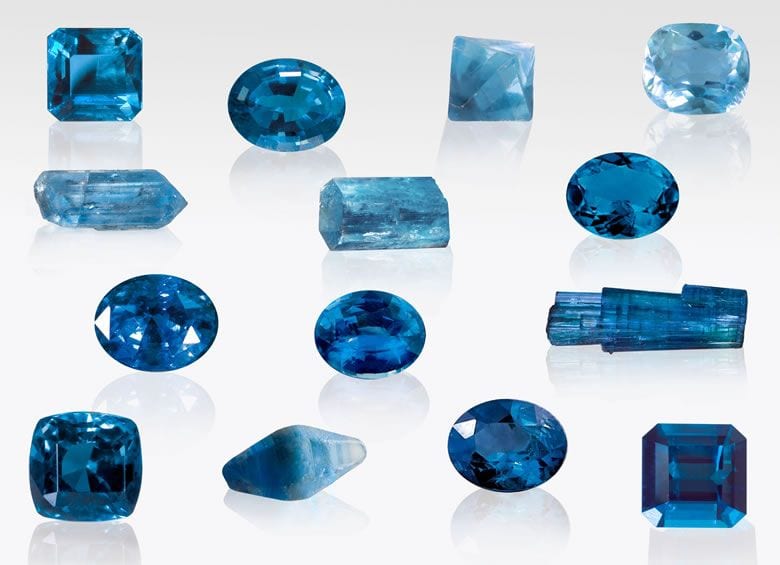Blue stones come in many varieties and have been treasured for their beauty and symbolism across cultures and throughout history. Some of the most popular blue gemstones include sapphire, lapis lazuli, blue topaz, aquamarine, and turquoise. The striking blue color in these minerals comes from trace amounts of iron, titanium, or copper. The specific chemistry and structure of each stone determines the exact hue.
Sapphire
Sapphire is one of the most precious gemstones and comes in a range of blue shades, from light to dark. Its blue color is due to traces of iron and titanium. Sapphires belong to the mineral family corundum and have a Mohs hardness of 9, making them extremely durable. Blue sapphires can be found around the world, with significant deposits in Australia, Thailand, Sri Lanka, China, and Montana in the United States.
Some key facts about blue sapphire:
| Color | Vivid blue in various shades |
|---|---|
| Lustre | Vitreous |
| Transparency | Transparent to opaque |
| Hardness | 9 |
| Chemical composition | Aluminum oxide with traces of iron and titanium |
Blue sapphires are associated with wisdom, virtue, and good fortune. They are the birthstone for the month of September and are frequently used in engagement rings and other jewelry pieces. Sapphires also hold religious and spiritual significance in many faiths, including Hinduism, Buddhism, and Christianity.
Lapis Lazuli
Lapis lazuli is a deep blue semi-precious stone that has been mined for over 6,000 years. Its name comes from the Latin word “lapis” meaning stone and the Persian word “lazward” meaning blue. The vivid blue color is due to the presence of sulfur and lazurite. Lapis lazuli is prized for its ornamental value and has a long history of use in jewelry, carvings, and mosaics.
Some key facts about lapis lazuli:
| Color | Deep blue with gold flecks |
|---|---|
| Lustre | Dull to vitreous |
| Transparency | Opaque |
| Hardness | 5 – 6 |
| Chemical composition | Lazurite, calcite, pyrite |
Lapis lazuli was particularly revered in Ancient Egypt where it was used to create jewelry, scarabs, and intricate carvings like the famous funerary mask of King Tutankhamun. It was also ground up to make the prized ultramarine pigment used in medieval painting. Today it remains a popular gemstone associated with truth, friendship, and wisdom. The finest lapis is sourced from Afghanistan.
Blue Topaz
Topaz is an aluminum silicate mineral that commonly forms in transparent crystals. While most topaz is colorless, trace impurities of iron can give it a blue tint. Blue topaz is the state gemstone of Texas. Some key facts include:
| Color | Light to medium blue |
|---|---|
| Lustre | Vitreous |
| Transparency | Transparent |
| Hardness | 8 |
| Chemical composition | Aluminum silicate with iron impurities |
The pale blue color of topaz closely resembles aquamarine. But blue topaz can be distinguished by its greater hardness and specific gravity. Most blue topaz stones are actually colorless in their raw state and are irradiated to produce the blue color. Blue topaz is associated with focus, discipline, and communication.
Aquamarine
Aquamarine is a light blue-green variety of the mineral beryl. It gets its sea-like color from trace amounts of iron. Some key facts:
| Color | Blue-green |
|---|---|
| Lustre | Vitreous |
| Transparency | Transparent to translucent |
| Hardness | 7.5 – 8 |
| Chemical composition | Beryllium aluminum silicate with iron |
The largest aquamarine gemstones come from Brazil, but it is also mined in Africa, Pakistan, and India. Aquamarine ranges from very pale blue to deeper blue-green hues. Darker stones are considered more valuable. Aquamarine is the birthstone for March and is associated with courage, tranquility, and clear communication. It was believed to protect sailors and was used extensively for nautical equipment.
Turquoise
Turquoise is an opaque gemstone ranging from sky blue to greenish blue. It has been prized for thousands of years by ancient civilizations of the Americas, Egyptians, Persians, and Chinese. Here are some key characteristics:
| Color | Blue to greenish blue |
|---|---|
| Lustre | Waxy to dull |
| Transparency | Opaque |
| Hardness | 5 – 6 |
| Chemical composition | Hydrated phosphate of copper and aluminum |
The distinctive color comes from copper. Turquoise is formed in arid climates by percolating groundwater. It has been extensively used by Native Americans in jewelry and ornamentation. The Southwest United States and Sinai, Egypt are important sources. Turquoise represents wisdom, tranquility, and good fortune.
Conclusion
Blue gemstones come in many striking shades and have diverse geological origins. Sapphire, lapis lazuli, blue topaz, aquamarine, and turquoise are some of the most popular blue stones used in jewelry and ornamentation for thousands of years. They carry rich cultural significance and meanings. Blue stones continue to be prized in modern times for their beauty, durability, and connection to the human spirit. Their mystical blue hues will likely captivate us for generations to come.


